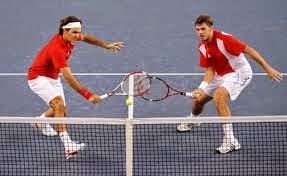I have already blogged about
off-court advance preparation for playing a multi-day tournament. But I am often asked by parents about what their players should eat during the event. Naturally this depends on the player, but the same common sense fuel strategies that apply to other sports will also work for tennis.
Hydration and Electrolytes
WATER!! Water is so important for all of us humans, regardless of our fitness level. Be sensible. Encourage your child to never pass up an opportunity for a drink of water. Specifically I am thinking

of getting a drink 'on the switch', when players switch ends of court after every odd number of completed games. On the switch is the only time players are allowed to stop for a drink. If you don't get a drink then, you can't just stop and get one whenever you are thirsty. I have some students who think they are showing me how tough they are by never wanting to take a drink break. This is a recipe for cramps and failure. Of course, too much of a good thing can be harmful as well. Gulping gallons of water can lead to uncomfortable fullness, too many bathroom breaks/interruptions, and in extreme cases, extreme consequences too unpleasant to mention here. Okay, I will mention: yes, people have died from drinking too much water. A good strategy is to sip at every opportunity and drink when thirsty. Also take a drink of water if feeling hungry - thirst sometimes masquerades as hunger.
Sports drinks - I have already talked about
electrolytes and why they are important here. Suffice to say moderation is what we are after. These drinks contain electrolytes, but they also often contain lots of sugar and artificial coloring. I have also found many of my students, like myself, don't care for them or tend to get a stomach ache when drinking them during competition. Not sure why, just FYI.
On to
solid nutrition options:
Fruit - bananas, orange slices, frozen grapes, melons, basically any hydrating fruit your child enjoys. I once had a pound of plums disappear at a Jr. Team Tennis practice like they were little round purple bars of gold.
Yogurt - satisfying and easy to digest. Just don't overdo it as many yogurts can be high in sugar.
Nutrition bar - individually packaged, easy to toss in the bag, doesn't need a cooler. What we are going for here is a slow, even release of energy for your player. Nibble, don't gobble.
The Free Lunch
Tournaments often provide lunch for the players. What is offered varies widely. I have seen everything from cold cut subs/sandwiches to pizza to meat-and-three (it's a southern thing). You want to avoid the afternoon slump or worse, cramping, that can arise after eating a heavy meal for lunch. Definitely no fast food. Avoid anything that will require lots of effort for your digestive system. This diverts energy from other parts of the body which may be needed for chasing down lobs! You can call the tournament director and ask what they will be serving, or just bring your own snacks JIC (Just In Case). If it were up to me, I would offer cold cuts/subs for all tournament lunches. Good combination of carbs, protein and veg, not too heavy, and most people like them. When our facility hosted the Jr. Team Tennis Nationals recently, they also had a smoothie vendor. Smoothies are a tasty and more or less healthy snack option, but again, enjoy in moderation.

What NOT to eat is so much easier. Avoid the usual suspects:
Fast food
Sweets
Fried food
Soda
Also avoid any foods new to your player that might be offered at the event. The chicken Caesar garlic wrap with tzatziki and quinoa may seem healthy and smell delicious, but tournament day is not the day to test if your player's stomach can tolerate whole grains and Greek food.
Bottom line: during the tournament, you want to eat like a world class athlete.
WWFE (What Would Federer Eat?)




























.JPG)
















